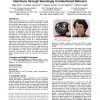Free Online Productivity Tools
i2Speak
i2Symbol
i2OCR
iTex2Img
iWeb2Print
iWeb2Shot
i2Type
iPdf2Split
iPdf2Merge
i2Bopomofo
i2Arabic
i2Style
i2Image
i2PDF
iLatex2Rtf
Sci2ools
HRI
2009
ACM
2009
ACM
Nonverbal leakage in robots: communication of intentions through seemingly unintentional behavior
Human communication involves a number of nonverbal cues that are seemingly unintentional, unconscious, and automatic—both in their production and perception—and convey rich information on the emotional state and intentions of an individual. One family of such cues is called “nonverbal leakage.” In this paper, we explore whether people can read nonverbal leakage cues—particularly gaze cues—in humanlike robots and make inferences on robots’ intentions, and whether the physical design of the robot affects these inferences. We designed a gaze cue for Geminoid—a highly e android—and Robovie—a robot with stylized, abstract humanlike features—that allowed the robots to “leak” information on what they might have in mind. In a controlled laboratory experiment, we asked participants to play a game of guessing with either of the robots and evaluated how the gaze cue affected participants’ task performance. We found that the gaze cue did, in fact, lead to better perfor...
Gaze Cue | HRI 2009 | Nonverbal Leakage | Robot |
| Added | 22 Jul 2010 |
| Updated | 22 Jul 2010 |
| Type | Conference |
| Year | 2009 |
| Where | HRI |
| Authors | Bilge Mutlu, Fumitaka Yamaoka, Takayuki Kanda, Hiroshi Ishiguro, Norihiro Hagita |
Comments (0)

